初中英语各种时态总结
初中英语语法总结8种时态
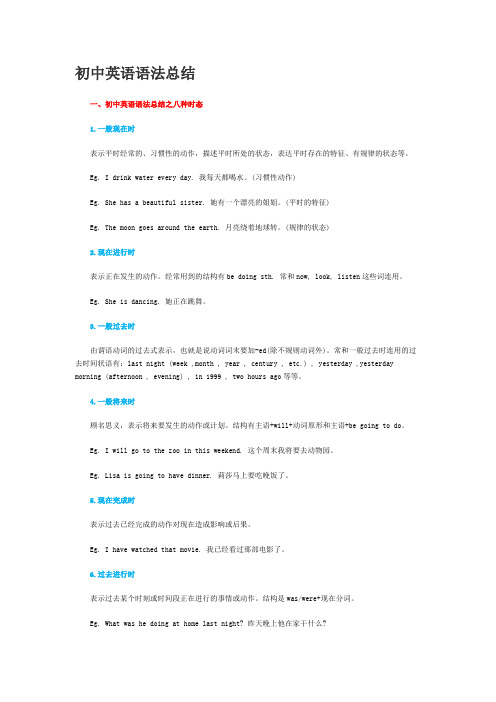
初中英语语法总结一、初中英语语法总结之八种时态1.一般现在时表示平时经常的、习惯性的动作,描述平时所处的状态,表达平时存在的特征、有规律的状态等。
Eg. I drink water every day. 我每天都喝水。
(习惯性动作)Eg. She has a beautiful sister. 她有一个漂亮的姐姐。
(平时的特征)Eg. The moon goes around the earth. 月亮绕着地球转。
(规律的状态)2.现在进行时表示正在发生的动作。
经常用到的结构有be doing sth. 常和now, look, listen这些词连用。
Eg. She is dancing. 她正在跳舞。
3.一般过去时由谓语动词的过去式表示,也就是说动词词末要加-ed(除不规则动词外)。
常和一般过去时连用的过去时间状语有:last night (week ,month , year , century , etc.) , yesterday ,yesterday morning (afternoon , evening) , in 1999 , two hours ago等等。
4.一般将来时顾名思义,表示将来要发生的动作或计划。
结构有主语+will+动词原形和主语+be going to do。
Eg. I will go to the zoo in this weekend. 这个周末我将要去动物园。
Eg. Lisa is going to have dinner. 莉莎马上要吃晚饭了。
5.现在完成时表示过去已经完成的动作对现在造成影响或后果。
Eg. I have watched that movie. 我已经看过那部电影了。
6.过去进行时表示过去某个时刻或时间段正在进行的事情或动作。
结构是was/were+现在分词。
Eg. What was he doing at home last night? 昨天晚上他在家干什么?7.过去将来时表示过去的某时以后将要发生的动作。
初中英语八种时态总结归纳
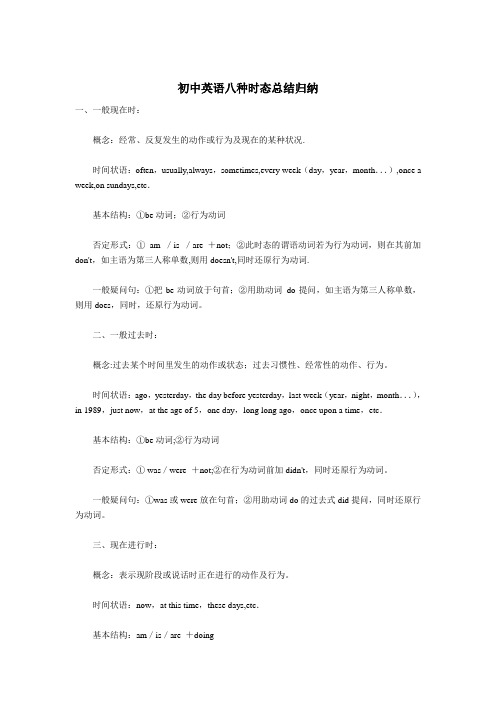
初中英语八种时态总结归纳一、一般现在时:概念:经常、反复发生的动作或行为及现在的某种状况.时间状语:often,usually,always,sometimes,every week(day,year,month...),once a week,on sundays,etc.基本结构:①be动词;②行为动词否定形式:①am /is /are +not;②此时态的谓语动词若为行为动词,则在其前加don't,如主语为第三人称单数,则用doesn't,同时还原行为动词.一般疑问句:①把be动词放于句首;②用助动词do提问,如主语为第三人称单数,则用does,同时,还原行为动词。
二、一般过去时:概念:过去某个时间里发生的动作或状态;过去习惯性、经常性的动作、行为。
时间状语:ago,yesterday,the day before yesterday,last week(year,night,month...),in 1989,just now,at the age of 5,one day,long long ago,once upon a time,etc.基本结构:①be动词;②行为动词否定形式:① was/were +not;②在行为动词前加didn't,同时还原行为动词。
一般疑问句:①was或were放在句首;②用助动词do的过去式did提问,同时还原行为动词。
三、现在进行时:概念:表示现阶段或说话时正在进行的动作及行为。
时间状语:now,at this time,these days,etc.基本结构:am/is/are +doing否定形式:am/is/are +not+doing一般疑问句:把be动词放在句首四、过去进行时:概念:表示过去某段时间或某一时刻正在发生或进行的行为或动作。
时间状语:at this time yesterday,at that time或以when引导的谓语动词是一般过去时的时间状语等。
初中英语时态总结表
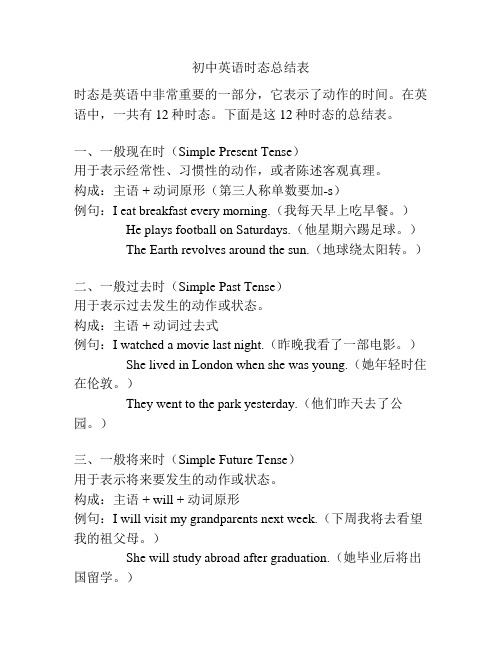
初中英语时态总结表时态是英语中非常重要的一部分,它表示了动作的时间。
在英语中,一共有12种时态。
下面是这12种时态的总结表。
一、一般现在时(Simple Present Tense)用于表示经常性、习惯性的动作,或者陈述客观真理。
构成:主语 + 动词原形(第三人称单数要加-s)例句:I eat breakfast every morning.(我每天早上吃早餐。
)He plays football on Saturdays.(他星期六踢足球。
)The Earth revolves around the sun.(地球绕太阳转。
)二、一般过去时(Simple Past Tense)用于表示过去发生的动作或状态。
构成:主语 + 动词过去式例句:I watched a movie last night.(昨晚我看了一部电影。
)She lived in London when she was young.(她年轻时住在伦敦。
)They went to the park yesterday.(他们昨天去了公园。
)三、一般将来时(Simple Future Tense)用于表示将来要发生的动作或状态。
构成:主语 + will + 动词原形例句:I will visit my grandparents next week.(下周我将去看望我的祖父母。
)She will study abroad after graduation.(她毕业后将出国留学。
)They will have a party on Friday.(他们将在星期五举行一个派对。
)四、现在进行时(Present Continuous Tense)用于表示现在正在进行的动作。
构成:主语 + am/is/are + 现在分词(-ing形式)例句:I am reading a book now.(我现在在读一本书。
)She is playing the piano at the moment.(她此刻正在弹钢琴。
初中所有英语时态
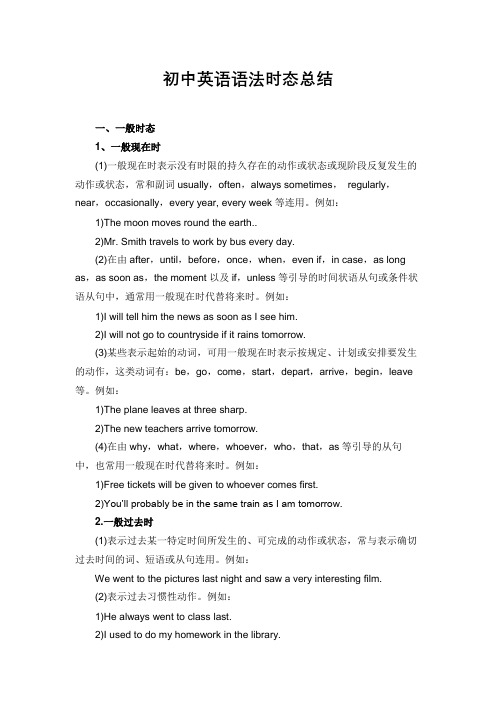
初中英语语法时态总结一、一般时态1、一般现在时(1)一般现在时表示没有时限的持久存在的动作或状态或现阶段反复发生的动作或状态,常和副词usually,often,always sometimes,regularly,near,occasionally,every year, every week等连用。
例如:1)The moon moves round the earth..2)Mr. Smith travels to work by bus every day.(2)在由after,until,before,once,when,even if,in case,as long as,as soon as,the moment以及if,unless等引导的时间状语从句或条件状语从句中,通常用一般现在时代替将来时。
例如:1)I will tell him the news as soon as I see him.2)I will not go to countryside if it rains tomorrow.(3)某些表示起始的动词,可用一般现在时表示按规定、计划或安排要发生的动作,这类动词有:be,go,come,start,depart,arrive,begin,leave 等。
例如:1)The plane leaves at three sharp.2)The new teachers arrive tomorrow.(4)在由why,what,where,whoever,who,that,as等引导的从句中,也常用一般现在时代替将来时。
例如:1)Free tickets will be given to whoever comes first.2)You’ll probably be in the same train as I am tomorrow.2.一般过去时(1)表示过去某一特定时间所发生的、可完成的动作或状态,常与表示确切过去时间的词、短语或从句连用。
初中英语八大时态归纳总结
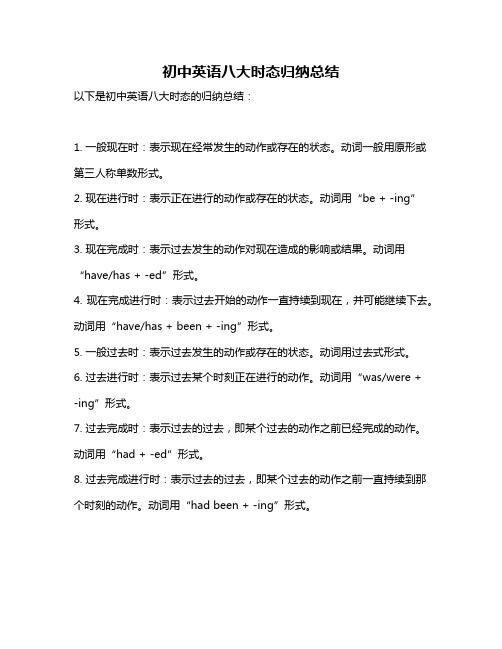
初中英语八大时态归纳总结
以下是初中英语八大时态的归纳总结:
1. 一般现在时:表示现在经常发生的动作或存在的状态。
动词一般用原形或第三人称单数形式。
2. 现在进行时:表示正在进行的动作或存在的状态。
动词用“be + -ing”
形式。
3. 现在完成时:表示过去发生的动作对现在造成的影响或结果。
动词用“have/has + -ed”形式。
4. 现在完成进行时:表示过去开始的动作一直持续到现在,并可能继续下去。
动词用“have/has + been + -ing”形式。
5. 一般过去时:表示过去发生的动作或存在的状态。
动词用过去式形式。
6. 过去进行时:表示过去某个时刻正在进行的动作。
动词用“was/were + -ing”形式。
7. 过去完成时:表示过去的过去,即某个过去的动作之前已经完成的动作。
动词用“had + -ed”形式。
8. 过去完成进行时:表示过去的过去,即某个过去的动作之前一直持续到那个时刻的动作。
动词用“had been + -ing”形式。
以上是初中英语的八大时态,理解和掌握这些时态对于英语学习和交流非常重要。
初中英语九大时态总结

初中英语九大时态总结初中英语九大时态总结一、一般现在时:概念:经常、反复发生的动作或行为及现在的某种状况。
时间状语:often,usually,always,sometimes,everyweek(day,year,month...),onceaweek,onSundays,etc.基本结构:①be动词;②行为动词否定形式:①am/is/are+not;②此时态的谓语动词若为行为动词,则在其前加don”t,如主语为第三人称单数,则用doesn”t,同时还原行为动词。
一般疑问句:①把be动词放于句首;②用助动词do提问,如主语为第三人称单数,则用does,同时,还原行为动词。
二、一般过去时:概念:过去某个时间里发生的动作或状态;过去习惯性、经常性的动作、行为。
时间状语:ago,yesterday,thedaybeforeyesterday,lastweek(year,night,month...),in1989,justnow,attheageof5,oneday,longlongago,onceuponatime,etc.基本结构:①be动词;②行为动词否定形式:①was/were+not;②在行为动词前加didn”t,同时还原行为动词。
一般疑问句:①was或were放在句首;②用助动词do的过去式did提问,同时还原行为动词。
三、现在进行时:概念:表示现阶段或说话时正在进行的动作及行为。
时间状语:now,atthistime,thesedays,etc.基本结构:am/is/are+doing否定形式:am/is/are+not+doing一般疑问句:把be动词放在句首四、过去进行时:概念:表示过去某段时间或某一时刻正在发生或进行的行为或动作。
时间状语:atthistimeyesterday,atthattime或以when引导的谓语动词是一般过去时的时间状语等。
基本结构:was/were+doing否定形式:was/were+not+doing一般疑问句:把was或were放在句首五、现在完成时:概念:过去发生或已经完成的动作对现在造成的影响或结果,或从过去已经开始,持续到现在的动作或状态。
初中英语八种时态总结归纳
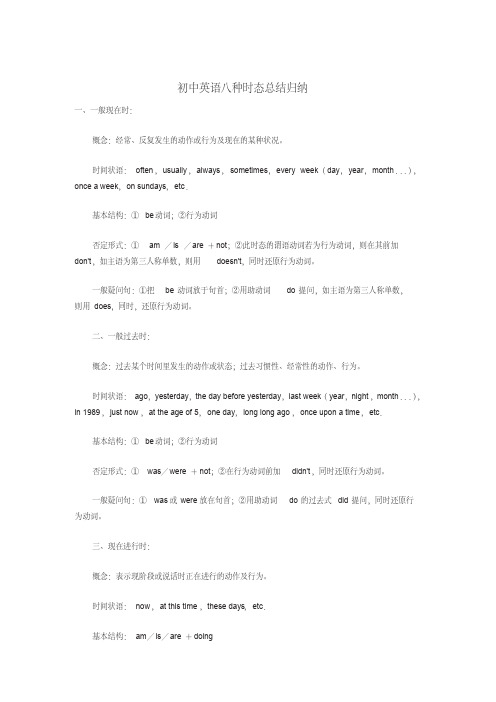
初中英语八种时态总结归纳一、一般现在时:概念:经常、反复发生的动作或行为及现在的某种状况。
时间状语:often,usually,always,sometimes,every week(day,year,month...),once a week,on sundays,etc.基本结构:①be动词;②行为动词否定形式:①am/is/are+not;②此时态的谓语动词若为行为动词,则在其前加don't,如主语为第三人称单数,则用doesn't,同时还原行为动词。
一般疑问句:①把be动词放于句首;②用助动词do提问,如主语为第三人称单数,则用does,同时,还原行为动词。
二、一般过去时:概念:过去某个时间里发生的动作或状态;过去习惯性、经常性的动作、行为。
时间状语:ago,yesterday,the day before yesterday,last week(year,night,month...),in 1989,just now,at the age of 5,one day,long long ago,once upon a time,etc.基本结构:①be动词;②行为动词否定形式:① was/were+not;②在行为动词前加didn't,同时还原行为动词。
一般疑问句:①was或were放在句首;②用助动词do的过去式did提问,同时还原行为动词。
三、现在进行时:概念:表示现阶段或说话时正在进行的动作及行为。
时间状语:now,at this time,these days,etc.基本结构:am/is/are+doing否定形式:am/is/are+not+doing一般疑问句:把be动词放在句首四、过去进行时:概念:表示过去某段时间或某一时刻正在发生或进行的行为或动作。
时间状语:at this time yesterday,at that time或以when引导的谓语动词是一般过去时的时间状语等。
总结归纳初中七个时态

总结归纳初中七个时态一、过去时态(Simple Past Tense)过去时态用来表示发生在过去的动作、状态或习惯。
它通常由动词的过去式构成,或者加上助动词“did”来表达否定或疑问。
1. 肯定句:主语 + 动词过去式 + 其他成分例:他昨天去了看电影。
2. 否定句:主语 + did not/didn't + 动词原形 + 其他成分例:我没有做我的作业。
3. 疑问句:Did + 主语 + 动词原形 + 其他成分?例:他昨天去了看电影吗?二、现在时态(Simple Present Tense)现在时态用来表示现在的动作、状态或经常性发生的动作。
它通常由动词的原形构成,第三人称单数形式要在动词后面加上“-s”。
1. 肯定句:主语 + 动词原形/动词第三人称单数形式 + 其他成分例:他每天做作业。
2. 否定句:主语 + do/does not/doesn't + 动词原形 + 其他成分例:我不喜欢吃苹果。
3. 疑问句:Do/Does + 主语 + 动词原形 + 其他成分?例:你每天去学校吗?三、将来时态(Simple Future Tense)将来时态用来表示将来的动作、状态或打算做某事。
它通常由情态动词“will”或者“be going to”加上动词的原形构成。
1. 肯定句:主语 + will + 动词原形 + 其他成分例:我明天会去购物。
2. 否定句:主语 + will not/won't + 动词原形 + 其他成分例:他不会参加派对。
3. 疑问句:Will + 主语 + 动词原形 + 其他成分?例:你会帮我吗?四、过去进行时态(Past Continuous Tense)过去进行时态用来表示过去某一时间正在进行的动作或事件。
它由“was/were”加上动词的现在分词构成。
1. 肯定句:主语 + was/were + 动词的现在分词 + 其他成分例:他昨天这个时候正在做作业。
初中英语九大时态总结
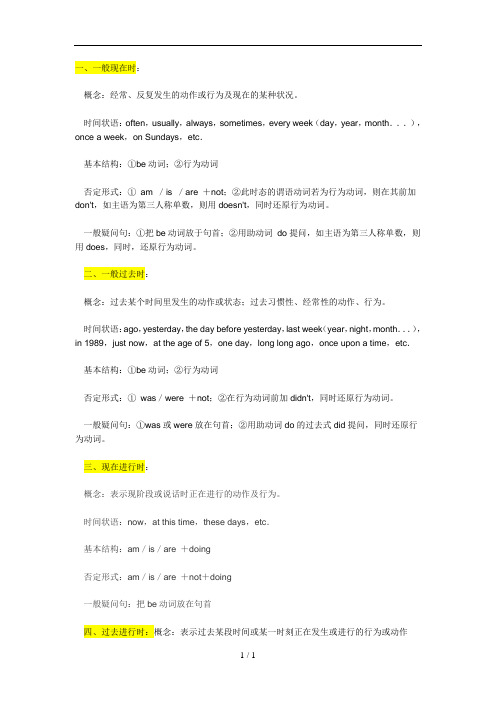
一、一般现在时:概念:经常、反复发生的动作或行为及现在的某种状况。
时间状语:often,usually,always,sometimes,every week(day,year,month...),once a week,on Sundays,etc.基本结构:①be动词;②行为动词否定形式:①am /is /are +not;②此时态的谓语动词若为行为动词,则在其前加don't,如主语为第三人称单数,则用doesn't,同时还原行为动词。
一般疑问句:①把be动词放于句首;②用助动词do提问,如主语为第三人称单数,则用does,同时,还原行为动词。
二、一般过去时:概念:过去某个时间里发生的动作或状态;过去习惯性、经常性的动作、行为。
时间状语:ago,yesterday,the day before yesterday,last week(year,night,month...),in 1989,just now,at the age of 5,one day,long long ago,once upon a time,etc.基本结构:①be动词;②行为动词否定形式:①was/were +not;②在行为动词前加didn't,同时还原行为动词。
一般疑问句:①was或were放在句首;②用助动词do的过去式did提问,同时还原行为动词。
三、现在进行时:概念:表示现阶段或说话时正在进行的动作及行为。
时间状语:now,at this time,these days,etc.基本结构:am/is/are +doing否定形式:am/is/are +not+doing一般疑问句:把be动词放在句首四、过去进行时:概念:表示过去某段时间或某一时刻正在发生或进行的行为或动作时间状语:at this time yesterday,at that time或以when引导的谓语动词是一般过去时的时间状语等。
初中英语时态归纳总结
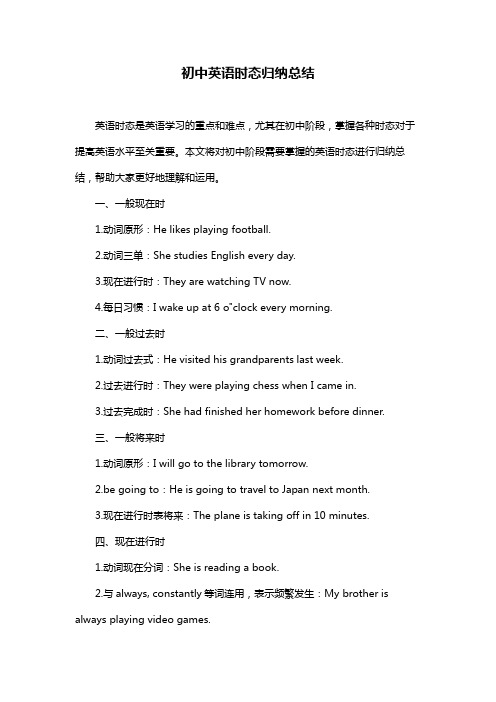
初中英语时态归纳总结英语时态是英语学习的重点和难点,尤其在初中阶段,掌握各种时态对于提高英语水平至关重要。
本文将对初中阶段需要掌握的英语时态进行归纳总结,帮助大家更好地理解和运用。
一、一般现在时1.动词原形:He likes playing football.2.动词三单:She studies English every day.3.现在进行时:They are watching TV now.4.每日习惯:I wake up at 6 o"clock every morning.二、一般过去时1.动词过去式:He visited his grandparents last week.2.过去进行时:They were playing chess when I came in.3.过去完成时:She had finished her homework before dinner.三、一般将来时1.动词原形:I will go to the library tomorrow.2.be going to:He is going to travel to Japan next month.3.现在进行时表将来:The plane is taking off in 10 minutes.四、现在进行时1.动词现在分词:She is reading a book.2.与always, constantly等词连用,表示频繁发生:My brother is always playing video games.五、过去进行时1.动词过去分词:They were discussing the project.2.与at that time, at this moment等词连用,表示在某个时间正在进行的动作:At that time, she was sleeping.六、完成时1.现在完成时:I have finished my homework.2.过去完成时:He had left the classroom before I arrived.七、被动语态1.一般现在时:The book is written by him.2.一般过去时:The window was broken by Tom.3.一般将来时:The letter will be sent to her tomorrow.总结:初中英语时态的学习需要掌握一般现在时、一般过去时、一般将来时、现在进行时、过去进行时、完成时和被动语态等。
初中英语语法八大时态总结完整版
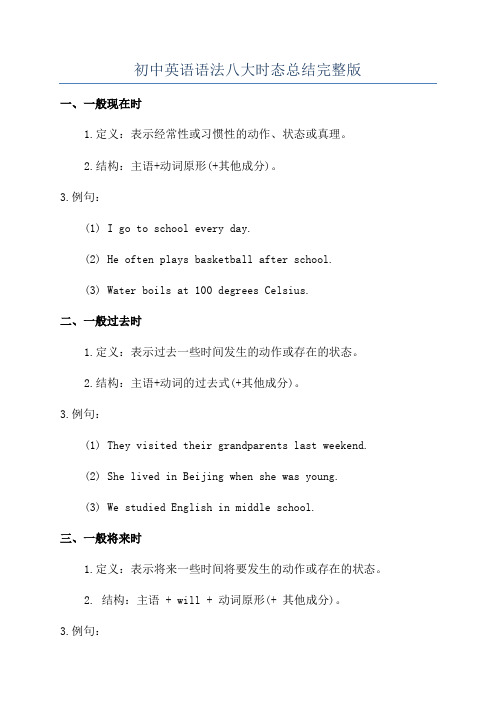
初中英语语法八大时态总结完整版一、一般现在时1.定义:表示经常性或习惯性的动作、状态或真理。
2.结构:主语+动词原形(+其他成分)。
3.例句:(1) I go to school every day.(2) He often plays basketball after school.(3) Water boils at 100 degrees Celsius.二、一般过去时1.定义:表示过去一些时间发生的动作或存在的状态。
2.结构:主语+动词的过去式(+其他成分)。
3.例句:(1) They visited their grandparents last weekend.(2) She lived in Beijing when she was young.(3) We studied English in middle school.三、一般将来时1.定义:表示将来一些时间将要发生的动作或存在的状态。
2. 结构:主语 + will + 动词原形(+ 其他成分)。
3.例句:(1) I will go to the park tomorrow.(3) We will have a party next week.四、现在进行时1.定义:表示现在正在进行的动作。
2. 结构:主语 + am/is/are + 动词-ing(+ 其他成分)。
3.例句:(1) She is reading a book right now.(2) They are playing soccer in the park.(3) We are having dinner at the moment.五、过去进行时1.定义:表示过去一些时间正在进行的动作。
2. 结构:主语 + was/were + 动词-ing(+ 其他成分)。
3.例句:(1) He was watching TV at 8 o'clock last night.(2) They were traveling in Europe during summer vacation.(3) We were studying when the phone rang.六、将来进行时1.定义:表示将来一些时间正在进行的动作。
初中英语语法八大时态总结(完整版)
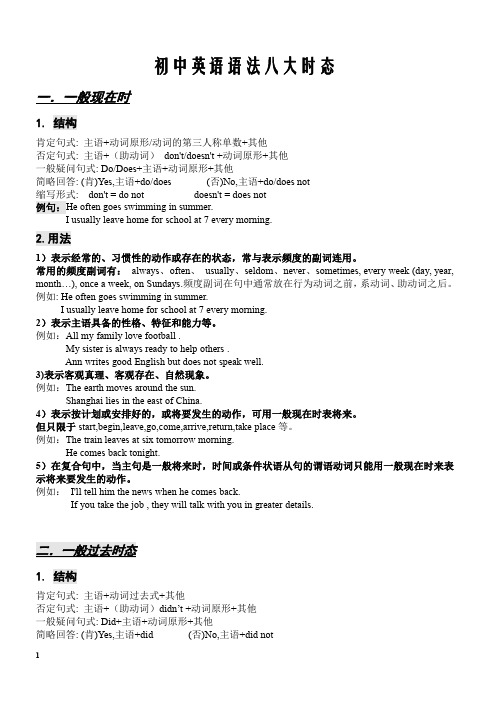
初中英语语法八大时态一.一般现在时1.结构肯定句式:主语+动词原形/动词的第三人称单数+其他否定句式:主语+(助动词)don't/doesn't+动词原形+其他一般疑问句式:Do/Does+主语+动词原形+其他简略回答:(肯)Yes,主语+do/does(否)No,主语+do/does not缩写形式:don't=do not doesn't=does not例句:He often goes swimming in summer.I usually leave home for school at7every morning.2.用法1)表示经常的、习惯性的动作或存在的状态,常与表示频度的副词连用。
常用的频度副词有:always、often、usually、seldom、never、sometimes,every week(day,year, month…),once a week,on Sundays.频度副词在句中通常放在行为动词之前,系动词、助动词之后。
例如:He often goes swimming in summer.I usually leave home for school at7every morning.2)表示主语具备的性格、特征和能力等。
例如:All my family love football.My sister is always ready to help others.Ann writes good English but does not speak well.3)表示客观真理、客观存在、自然现象。
例如:The earth moves around the sun.Shanghai lies in the east of China.4)表示按计划或安排好的,或将要发生的动作,可用一般现在时表将来。
但只限于start,begin,leave,go,come,arrive,return,take place等。
初中英语语法八大时态总结(完整版)
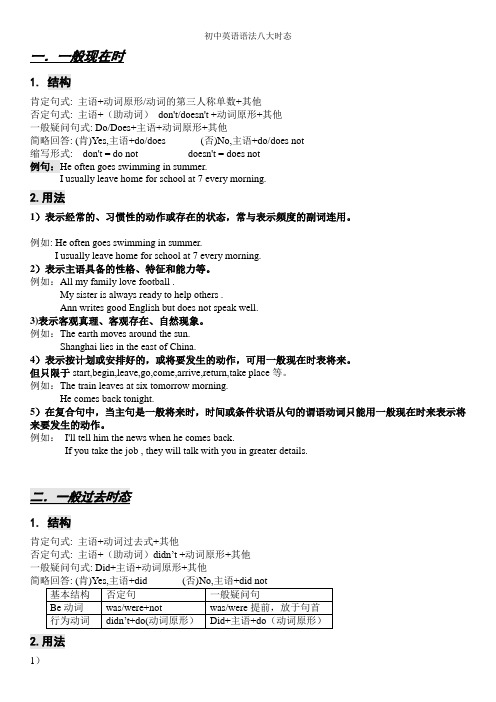
初中英语语法八大时态一.一般现在时1.结构肯定句式: 主语+动词原形/动词的第三人称单数+其他否定句式: 主语+(助动词)don't/doesn't +动词原形+其他一般疑问句式: Do/Does+主语+动词原形+其他简略回答: (肯)Yes,主语+do/does (否)No,主语+do/does not缩写形式: don't = do not doesn't = does not例句:He often goes swimming in summer.I usually leave home for school at 7 every morning.2.用法1)表示经常的、习惯性的动作或存在的状态,常与表示频度的副词连用。
例如: He often goes swimming in summer.I usually leave home for school at 7 every morning.2)表示主语具备的性格、特征和能力等。
例如:All my family love football .My sister is always ready to help others .Ann writes good English but does not speak well.3)表示客观真理、客观存在、自然现象。
例如:The earth moves around the sun.Shanghai lies in the east of China.4)表示按计划或安排好的,或将要发生的动作,可用一般现在时表将来。
但只限于start,begin,leave,go,come,arrive,return,take place等。
例如:The train leaves at six tomorrow morning.He comes back tonight.5)在复合句中,当主句是一般将来时,时间或条件状语从句的谓语动词只能用一般现在时来表示将来要发生的动作。
初中英语八种基本时态总结
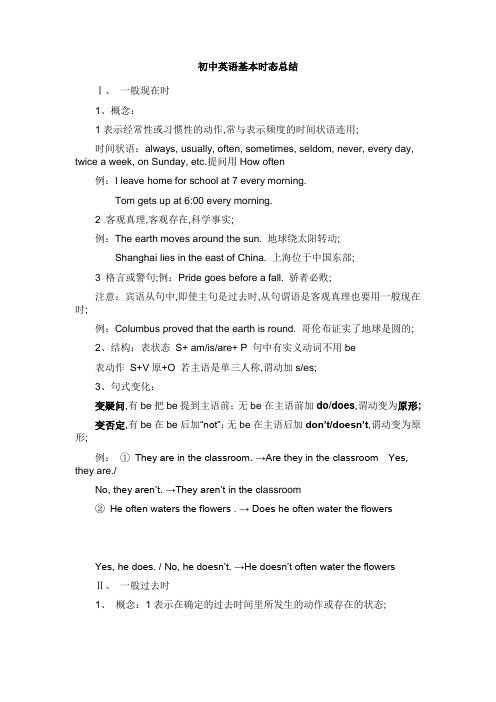
初中英语基本时态总结Ⅰ、一般现在时1、概念:1表示经常性或习惯性的动作,常与表示频度的时间状语连用;时间状语:always, usually, often, sometimes, seldom, never, every day, twice a week, on Sunday, etc.提问用How often例:I leave home for school at 7 every morning.Tom gets up at 6:00 every morning.2 客观真理,客观存在,科学事实;例:The earth moves around the sun. 地球绕太阳转动;Shanghai lies in the east of China. 上海位于中国东部;3 格言或警句;例:Pride goes before a fall. 骄者必败;注意:宾语从句中,即使主句是过去时,从句谓语是客观真理也要用一般现在时;例:Columbus proved that the earth is round. 哥伦布证实了地球是圆的;2、结构:表状态S+ am/is/are+ P 句中有实义动词不用be表动作S+V原+O 若主语是单三人称,谓动加s/es;3、句式变化:变疑问,有be把be提到主语前;无be在主语前加do/does,谓动变为原形;变否定,有be在be后加“not”;无be在主语后加don’t/doesn’t,谓动变为原形;例:①They are in the classroom. →Are they in the classroom Yes, they are./No, they aren’t. →They aren’t in the cl assroom②He often waters the flowers . → Does he often water the flowersYes, he does. / No, he doesn’t. →He doesn’t often water the flowersⅡ、一般过去时1、概念:1表示在确定的过去时间里所发生的动作或存在的状态;常用时间状语:yesterday, the day before yesterday, last week, just now, an hour ago, the other day, in 1982. at the age of 5, one day, long long ago, etc.例:Where did you go just now2表示在过去一段时间内,经常性或习惯性的动作;例:When I was a child, I often played football in the street.2、结构:表状态S+ was/were+ P表动作S+V过去式+O 注:句中有实义动词不用be3、句式变化:变疑问,有be把be提到主语前;无be在主语前加did,谓动变为原形;变否定,有be在be后直接加“not”;无be在主语后加didn’t,谓动变为原形.例:①She was in Xi’an last month. → Was she in Xi’an last monthYes, she was. /No, she wasn’t. →She wasn’t in Xi’an last month.②Danny grew a rose just now, → Did Danny grow a rose just nowYes, he did. / No, he didn’t. →Danny didn’t grow a rose just now,Ⅲ、现在进行时:1. 概念:表示现阶段或说话时正在进行的动作;时间状语:now, at this time, these days,以及有look, listen时;例:ListenThe birds are singing.2、结构:S + am/is/are + doing助动现在分词3、句式变化:变疑问,把am/is/are提到主语前;变否定,在am/is/are后直接加“not”;例:①I am writing a letter now. → Are you writing a letter nowYes, I am. /No, I’m not. →I am not writing a letter now. 注:am和not不能缩写;②The boys are playing football. → Are the boys playing footballYes, they are. / No, they aren’t. →The boys aren’t playing football.Ⅳ、过去进行时:1. 概念:表示过去某段时间或某一时刻正在发生或进行的动作;.时间状语:at this time yesterday, at that time,at 8:00 yesterday,或有when / while引导的时间状语从句等;例:We were having an English class at 9:30 yesterday morning.I was reading a book while my mother was watching TV.2、结构:S + was/were + doing3、句式变化:变疑问,把was/were提到主语前;变否定,在was/were后直接加“not”;例:①At that time they were working in the garden. → Were they working inthe garden at that timeYes, they were. / No, they weren’t.→At that time they were working in the garden.②When he came in, I was reading a newspaper. →When he came in, were you reading a newspaperYes, I was. / No, I wasn’t.→When he came in, I wasn’t reading a newspaper.Ⅴ、一般将来时1. 概念:表示将要发生的动作或存在的状态;时间词:tomorrow, tomorrow morning, at seven o'clock tomorrow evening, next year, this year, at the end of this term, from now,in ten minutes, in 2025例:They will do an experiment tomorrow afternoon.Brian is going to draw twenty pictures at the end of this term.2、结构:S +will+ V原+其他will 可改为be going to ,当主语是第一人称时will可用shall例:Which paragraph shall I read first 我先读哪一段呢Will you/Are you going tobe at home at seven this evening3、句式变化:变疑问,把will提到主语前;变否定,在will后直接加“not”;例; She will drive to Beijing next week. → Will she drive to Beijing next weekYes, she will. / No, she won’t. →She won’t drive to Beijing next week.★be going to + V原表示a. 主语的意图,即将做某事;例:What are you going to do tomorrowb. 计划,安排要发生的事;例:The play is going to be produced next month;c. 有迹象要发生的事;例:Look at the dark clouds, there is going to be a storm.★be +不定式:表示将来,按计划或正式安排将发生的事;例:We are to discuss the report next Saturday. 我们下星期六将讨论这份报告★用现在进行时表示将来come, go, arrive, leave, start, begin, return等终止性动词可用现在进行时表示将来;例:I'm leaving tomorrow. 明天我要走了;Are you staying here till next week 你会在这儿呆到下周吗Ⅶ、现在完成时:1. 表示:①过去发生或已经完成的动作对现在造成的影响或结果;时间词:ever, never, already, yet, before, just, recently/ lately最近, in the past few years2. ②或从过去已经开始持续到现在的动作或状态; 时间词:for + 时间段,since +过去时间点/从句;提问用How long例:The countryside has changed a lot in the past few years.He has learned French for two years.2.结构:S + have/has + done助动过去分词3. 句式变化:变疑问,把have/has提到主语前;变否定,在have/has后直接加“not”;例:①I've already written an article. → Have you written an article yet Yes, I h ave. / No, I haven’t. →I haven’t written an article yet.②Li Ming has lived in Shijiazhuang since 1993.→ Has Li Ming lived in Shijiazhuang since 1993 Yes, he has. / No, he hasn’t.→Li Ming hasn’t lived in Shijiazhuang since 1993.★比较一般过去时与现在完成时1一般过去时表示过去某具体时间发生的动作或单纯叙述过去的事情,强调动作;现在完成时则强调过去发生的动作对现在的造成影响,强调的是结果;2一般过去时常与具体的时间状语连用,而现在完成时通常与模糊的时间状语连用,或无时间状语;例:I saw this film yesterday. 强调看的动作发生过了I have seen this film. 强调对现在的影响,电影的内容已经知道了Why did you get up so early 强调起床的动作已发生过了Who hasn't handed in his paper 强调有卷子未交,指结果He joined the League three years ago. 强调加入这一动作He has been a League member for three years. 是团员的状态可持续句子中如有过去时的时间副词如yesterday, last, week, in 1960时,不能使用现在完成时,要用过去时;错Tom has written a letter to his parents last night.对Tom wrote a letter to his parents last night.。
初中英语知识点总结时态

初中英语知识点总结时态初中英语时态知识点总结一、一般现在时(Simple Present Tense)一般现在时用于描述经常发生的动作、状态或普遍真理。
其构成通常是主语加上动词的原形,第三人称单数时动词要加-es/-s。
例句:- She often reads books before going to bed.(她经常在睡觉前读书。
)- The sun rises in the east.(太阳从东方升起。
)二、现在进行时(Present Continuous Tense)现在进行时表示正在进行或发生的动作。
其构成是be动词(am/is/are)加上动词的现在分词(即动词原形加-ing)。
例句:- He is playing football now.(他现在正在踢足球。
)- They are studying for the math test.(他们正在为数学考试学习。
)三、一般过去时(Simple Past Tense)一般过去时用于描述在过去某个确定时间发生的动作或状态。
动词通常在词尾加-ed,不规则动词则有特殊变化形式。
例句:- I visited my grandparents last weekend.(上周末我拜访了我的祖父母。
)- He walked to school yesterday.(昨天他走路去学校。
)四、过去进行时(Past Continuous Tense)过去进行时表示在过去某个时间点或时间段内正在进行的动作。
其构成是was/were加上动词的现在分词。
例句:- She was reading a book when I called her.(我给她打电话时,她正在读书。
)- They were playing basketball at this time yesterday.(昨天这个时候,他们在打篮球。
)五、一般将来时(Simple Future Tense)一般将来时用于描述将要发生的动作或状态。
初中英语语法八大时态总结
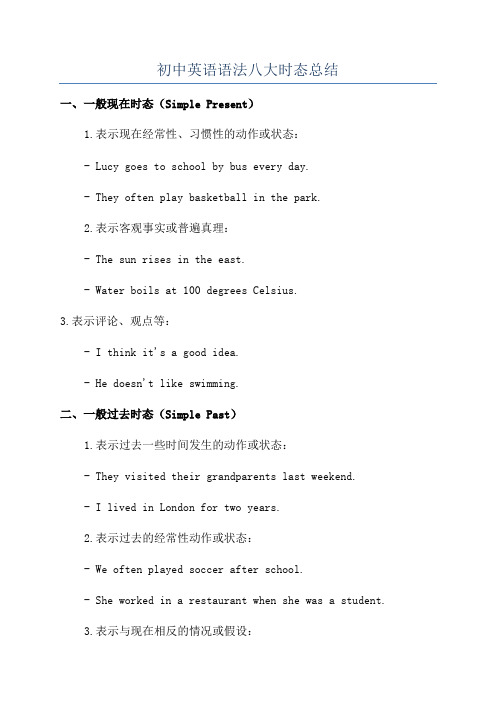
初中英语语法八大时态总结一、一般现在时态(Simple Present)1.表示现在经常性、习惯性的动作或状态:- Lucy goes to school by bus every day.- They often play basketball in the park.2.表示客观事实或普遍真理:- The sun rises in the east.- Water boils at 100 degrees Celsius.3.表示评论、观点等:- I think it's a good idea.- He doesn't like swimming.二、一般过去时态(Simple Past)1.表示过去一些时间发生的动作或状态:- They visited their grandparents last weekend.- I lived in London for two years.2.表示过去的经常性动作或状态:- We often played soccer after school.- She worked in a restaurant when she was a student.3.表示与现在相反的情况或假设:- If I had money, I would buy a new car.- I wish I could go to the concert with you.三、一般将来时态(Simple Future)1.表示将来要发生的事情:- I will meet him at the airport tomorrow.- They are going to have a party next week.2.表示意愿、打算或承诺:- I promise I will help you.- She is going to study abroad next year.四、现在进行时态(Present Continuous)1.表示现在正在进行或暂时的动作:- They are playing football in the park.- He is studying for the exam.2.表示现阶段的变化或趋势:- The population of the city is increasing rapidly.- More and more people are using smartphones.五、过去进行时态(Past Continuous)1.表示过去一些时间正在进行中的动作:- I was watching TV when she called me.- They were having dinner when the power went out.2.表示过去一些时间同时发生的两个动作:- While he was reading, his sister was playing the piano.- When I arrived, they were still waiting for you.六、将来进行时态(Future Continuous)1.表示将来一些时间正在进行的动作:- He will be sleeping when you arrive.2.表示将来一些时间同时发生的两个动作:- While you are washing the dishes, I will be cleaning the bathroom.- When I call you, she will be cooking dinner.七、现在完成时态(Present Perfect)1.表示过去发生但对现在有影响的动作或状态:- I have lost my key, so I can't open the door.- She has finished her homework, so she can watch TV now.2.表示经历或遭遇过的事情:- Have you ever been to Paris?- He has never seen such a beautiful sunset.八、过去完成时态(Past Perfect)1.表示在过去一些时间之前已经发生的动作或状态:- When I arrived, they had already left.2.表示过去一些时间之前一直存在或保持的状态:- He had lived in that house for 10 years before he moved out.- She had been planning the party for weeks.。
英语时态初中归纳总结
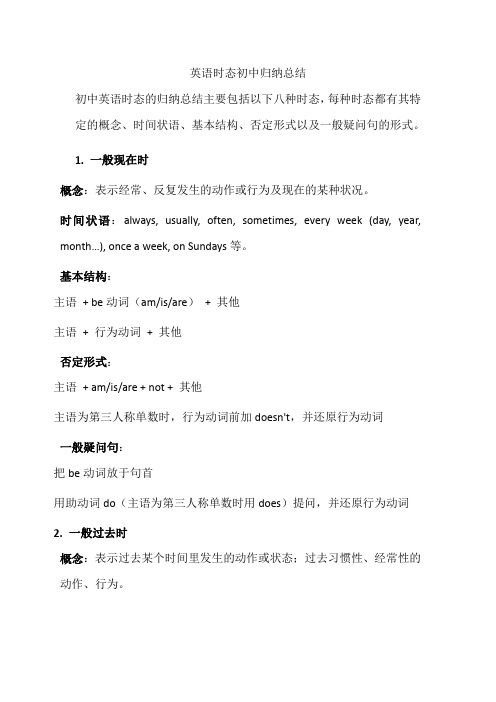
英语时态初中归纳总结初中英语时态的归纳总结主要包括以下八种时态,每种时态都有其特定的概念、时间状语、基本结构、否定形式以及一般疑问句的形式。
1. 一般现在时概念:表示经常、反复发生的动作或行为及现在的某种状况。
时间状语:always, usually, often, sometimes, every week (day, year, month…), once a week, on Sundays等。
基本结构:主语+ be动词(am/is/are)+ 其他主语+ 行为动词+ 其他否定形式:主语+ am/is/are + not + 其他主语为第三人称单数时,行为动词前加doesn't,并还原行为动词一般疑问句:把be动词放于句首用助动词do(主语为第三人称单数时用does)提问,并还原行为动词2. 一般过去时概念:表示过去某个时间里发生的动作或状态;过去习惯性、经常性的动作、行为。
时间状语:ago, yesterday, the day before yesterday, last week(year, night, month…), in 1989, just no w, at the age of 5, one day, long long ago, once upon a time等。
基本结构:主语+ be动词(was/were)+ 其他主语+ 行为动词(过去式)+ 其他否定形式:主语+ was/were + not + 其他在行为动词前加didn't,并还原行为动词一般疑问句:was或were放于句首用助动词do的过去式did提问,并还原行为动词3. 现在进行时概念:表示现阶段或说话时正在进行的动作及行为。
时间状语:now, at this time, these days等。
基本结构:主语+ am/is/are + doing + 其他否定形式:主语+ am/is/are + not + doing + 其他一般疑问句:把be动词放于句首4. 过去进行时概念:表示过去某段时间或某一时刻正在发生或进行的行为或动作。
初中英语八种时态归纳
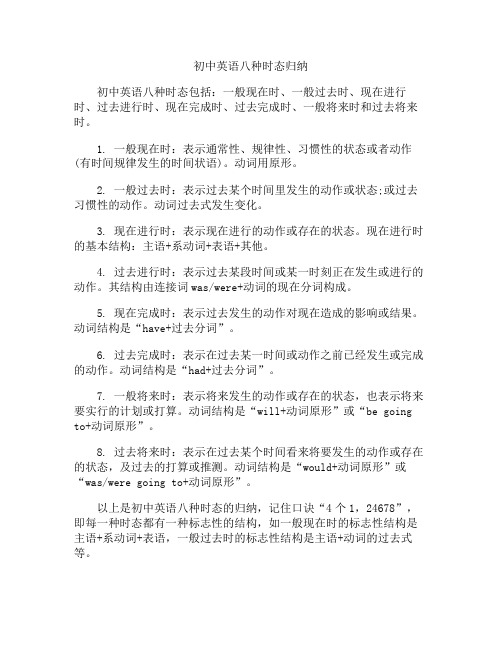
初中英语八种时态归纳
初中英语八种时态包括:一般现在时、一般过去时、现在进行时、过去进行时、现在完成时、过去完成时、一般将来时和过去将来时。
1. 一般现在时:表示通常性、规律性、习惯性的状态或者动作(有时间规律发生的时间状语)。
动词用原形。
2. 一般过去时:表示过去某个时间里发生的动作或状态;或过去习惯性的动作。
动词过去式发生变化。
3. 现在进行时:表示现在进行的动作或存在的状态。
现在进行时的基本结构:主语+系动词+表语+其他。
4. 过去进行时:表示过去某段时间或某一时刻正在发生或进行的动作。
其结构由连接词was/were+动词的现在分词构成。
5. 现在完成时:表示过去发生的动作对现在造成的影响或结果。
动词结构是“have+过去分词”。
6. 过去完成时:表示在过去某一时间或动作之前已经发生或完成的动作。
动词结构是“had+过去分词”。
7. 一般将来时:表示将来发生的动作或存在的状态,也表示将来要实行的计划或打算。
动词结构是“will+动词原形”或“be going to+动词原形”。
8. 过去将来时:表示在过去某个时间看来将要发生的动作或存在的状态,及过去的打算或推测。
动词结构是“would+动词原形”或“was/were going to+动词原形”。
以上是初中英语八种时态的归纳,记住口诀“4个1,24678”,即每一种时态都有一种标志性的结构,如一般现在时的标志性结构是主语+系动词+表语,一般过去时的标志性结构是主语+动词的过去式等。
- 1、下载文档前请自行甄别文档内容的完整性,平台不提供额外的编辑、内容补充、找答案等附加服务。
- 2、"仅部分预览"的文档,不可在线预览部分如存在完整性等问题,可反馈申请退款(可完整预览的文档不适用该条件!)。
- 3、如文档侵犯您的权益,请联系客服反馈,我们会尽快为您处理(人工客服工作时间:9:00-18:30)。
初结一、在时 1.概常、作在的某种状况 . 2.时间状语: Always, usually, often, sometimes, every week (day, year, month ⋯ ), once a week(day, year, month ⋯ ), on Sundays, 3.基本结构:动词原形 (如主语为第三人称单数 ,动词上要改为第三人称单数形式) 4.否定形式+a m /i s /a r e +n o t +其他 ;在其前加 don't, 为第三数用 d o e s n 't 还. 5.一句:把 词放于句首;词d o ,为第三数用 does,同 . 6.例句: . It seldom snows here. He is always ready to help others. Action speaks louder than words.. 二、 去时 1.概去作惯常作. 2.时间状语: ago, yesterday, the day before yesterday, last week, last(year, night, month ⋯ ), in 1989, just now, at the age of 5, one day, long long ago, once upon a time, etc. 3.构: 词去式 4.否定形式:主语+was/were +not+ 其他 ;在行为动词前加 didn't,同时还原行为动词. 5.一般疑问句: was 或 were 放于句首;用助动词do 的过去式 did 提问,同时还原行为动词. 6.例句: She often came to help us in those days. I didn't know you were so busy. 行时1.概念:阶作.2.时间状语: Now, at this time, days, etc. look. listen3.基本结构:主语+be +doing + 其他4.否定形式:主语+be +not +doing+ 其他5.一句:把 词放于句首 . 6.例句: How are you feeling today? He is doing well in his lessons. 行时 1.概念:去间或刻行作 . 2.时间状语: at this time yesterday, at that time 或以 when 引导的谓语动词是一般过去时的时 间状语等 . 3.基本结构 主语+was/were +doing + 其他 4.否定形式:主语+was/were + not +doing+ 其他 5.一般疑问句:把 was 或 were 放于句首 .(第一个字母大写) 6.例句: At that time she was working in a PLA unit. When he came in, I was reading a newspaper. 在完成时1.概生完现在造成的影果,开始到现 在的动作或状态. 2.时间状语: yet,already,just,never,ever,so far,by now,since+时间点 ,for+时间段 ,recently, lately, inthe past few years, etc.3.基本结构:主语+have/has +p.p (过去分词) +其他4.否定形式:主语+have/has + not +p.p (过去分词) +其他5.一般疑问句: have 或 has.6.例句: I've written an article.The countryside has changed a lot in the past few years. 去完成时1.概念去,在此作,作之前完成的行 为,即“过去的过去” .2.时间状语: Before, by the end of last year (term, month ⋯ ), etc.3.基本结构:主语+had + p.p (过去分词) +其他4.否定形式:主语+had + not +p.p (过去分词) +其他5.一般疑问句: had 放于句首 .6.例句: As soon as we got to the station, the train had left. By the end of last month. We had reviewed four books 基本结构:主语+had+p.p (过去分词) +其他 ①肯定句:主语+ had+p.p (过去分词) +其他②否定句:主语+ had+ not+p.p (过去分词) +其他③一般疑问句: Had+主语+p.p (过去分词) +其他④特句:特词 +一句 七、 一般将来时1.概念:表示作或存在及打划做某事 . 2.时间状语: Tomorrow, next day(week, month, year ⋯ ),soon, in a few minutes, by ⋯ ,the day after tomorrow, etc. 3.基本结构:主语+am/is/are +going to + do+ 其他;主语+will/shall + do+ 其他 4.否定形式:主语+am/is/are not going to do ;主语+will/shall not do+ 其他 5.一般疑问句: be 放于句首; will/shall 提到句首 . 6.例句: They are going to have a competition with us in studies. It is going to rain. 去将来时 1.概念:立去刻去看将来 ,常语从句中 . 2.时间状语: The next day (morning, year ⋯ ),the following month(week ⋯ ),etc. 3.基本结构:主语+was/were +going to + do+ 其他;主语+would/should + do+ 其他 4.否定形式:主语+was/were/not + going to + do; 主语+would/should + not + do. 5.一般疑问句: was 或 were 放于句首; would/should 提到句首 . 6.例句: He said he would go to Beijing the next day. I asked who was going there 九、将来完成时 1.概念:在将来刻之前开作或状态 2.时间状语: by the time of; by the end of+时间短语(将来) ;by the time+ 从句(将来) 3.基本结构:主语+be going to/will/shall + have+p.p (过去分词) +其他 4 例句 :By the time you get back, great changes will have taken place in this area. 在行时 1.概念:表去间开始一作续,并可到将来 . 2.基本结构:主语+have/has +been +doing+其他 3.时间状语: since+时间点 ,for+时间段等 .4.例子: I have been sitting here for an hour.The children have been watching TV since six o'clock.十一、在换 在中 词能与表示间 却不能 .但是 ,的 表达方式:用于“间 +a g o ”的的句型中;可改成 与应词,与用; 用于 “I t i s + 间+ since + 一般过去时”的句型中 ,表示“自从⋯ ⋯ 以来有⋯ ⋯时间”的意思 ,主句一般用 it is 来代替 It has been;④瞬间动词用于“ Some time has passed since + 一般过去时”的句型中 .请看: A. He joined the League two years ago. B. He has been in the League for two years. C. It is two years since he joined the League. D. Two years has passed since he joined the League. 十二、 换 在一般现在时中 ,at 加上名词表示“处于某种状态” ,如 at work (在工作) , at school (上学、 上课)等 .此短语可与进行时态转换.请看: Peter is at work, but Mike is at play. Peter is working, but Mike is playing. 辑本段 ]十与一般换在现在进行时态中 go, come, leave, start, arrive 等动词常与表示将来的时间状语连用表示将 要发生的动作 .如: I am coming, Mum! 意为“我就来 ,妈!”请看: The train is leaving soon. The train will leave soon. 名词复数的不规则变化 1)child---children foot---feet tooth---teeth mouse---mice man---men woman---women 注意:与 man 和 woman 构成的合成词,其复数形式也是 -men 和-women.如: an Englishman,two Englishmen. 但 German 不是合成词,故复数形式为G ermans ;Bowman是姓 ,其复数是 the Bowmans.2)单复同形 如:deer,sheep,fish,Chinese,Japaneseli,jin,yuan,two li,three mu,four jin但除元、角、分外 ,美元、法郎等都有复数形式 .如:a dollar, two dollars; a meter, two meters 3)集数形为复数 .如: people. police .cattle 等本身就是复数 ,不能说a people,a police,a cattle,但可以说 a person,a policeman,a head of cattle,the English,the British,the French,the Chinese,the Japanese,the Swiss 等名词,表示国民总称时,作复数用 . 如: The Chinese are industries and brave. 中国人民是勤劳勇敢的 . 4)以 s 结尾 ,仍为单数的名词,如:a. maths,politics,physics 等学科名词,为不可数名词,是单数.b. news 是不可数名词.c. the United States,the United Nations 应视为单数.The United Nations was organized in 1945. 联合国是1945 年组建起来的.d. 以复数形式出现的书名,剧名,报纸,杂志名,也可视为单数."The Arabian Nights" is a very interesting story-book.是一本非常有趣的故事书.5) 表示由两部分构成的东西,如:glasses (眼镜) trousers, clothes若表达具体数目,要借助数量词pair(对,双); suit( 套); a pair of glasses; two pairs of trousers6)另外还有一些名词,其复数形式有时可表示特别意思,如:goods 货物,waters 水域,fishes (各种)鱼。
